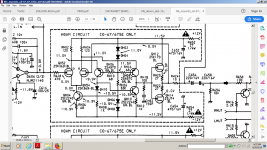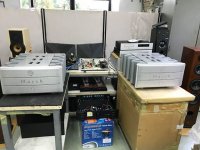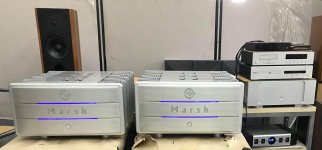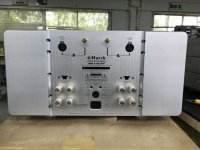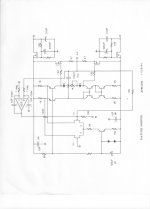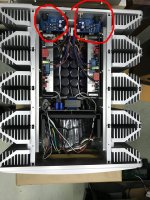my problem remains that his usual bibliography contains 8 of his own articles, a couple by Hawksford, and maybe one or two by Otala.
A disease often observed in authors from IBM, and also Texas Instruments, who submit to IEEE JSSC. As a reviewer I roasted their ahszhesses dozens of times, regrettably it sometimes had little effect (except rejection of revised manuscript).
🙂The 797 bears not even the least similarity to the 5534 BTW, well it has an input and an output.
The 5534 is a very good Swiss knife OMHO. And can drive lot of loads thanks to its current capability. It measure quite good as well. (some IC, now achieve incredible signal/distortion+noise ratios [Thanks Scott and few others], so why bother with old dinosaures ?).
The only problem is I always funded it sounding a little DULL. I don't know why.
Let-say it is a very good Pick-up, some should prefer super cars.
I used so many TL072, at a time, that I would have a bad time saying bad things about it. Works OK very few bucks. In some applications needs sometimes an output buffer.
I cannot understand why JC is so crossed against integrated circuits. They are everywhere and it is hard to live without.
Last edited:
Well, there are Kings, but in the end there can be only ONE Emperor...Hum.
Ruppert Neve must be turning in his grave.
No shipping from Thailand yet?
I decided to leave them in Thailand and listen to them there.
You remember I also live there, own place there and have retirement visa there?
-RNM
Last edited:
T, I use IC's, even the 5534 for my cheaper stuff, but I always seem to be able to make something better from discretes, especially with jfets. In 1978 or so, I carefully compared the 5534 with one of my studio quality discrete op amps and heard the difference. I even wrote up the comparison in TAA, back 40 years ago. I WANT IC's to work perfectly, that is the problem. They don't, at least for audio.
Attachments
Why? You forgot one detail I pointed out yesterday, designing an amplifier for a fixed application the designer has the freedom to change the compensation to suit the closed loop gain and now the BW does not change.
yes, I agree in that sense.
I have offered scholarly reading material/books that covers CMA in great detail over at the C vs V mode and what it means. I am doing as simple a comment here as I can. I refer all to my suggested reading to that forum, pls.
THx-RNMarsh
Last edited:
Ebay currently has a listing for the MPQ6600a matched complimentary package Richard used as a compromise for the discrete matched transistors for his line amp. The listing states their from the late James Bongiorno’s personal stash.
(x2 PCS.) MOTOROLA MPQ6600A QUAD DUAL IN-LINE SILICIN COMP. PAIR TRANSISTORS | eBay
(x2 PCS.) MOTOROLA MPQ6600A QUAD DUAL IN-LINE SILICIN COMP. PAIR TRANSISTORS | eBay
That was 40 years ago. What about now?T, I use IC's, even the 5534 for my cheaper stuff, but I always seem to be able to make something better from discretes, especially with jfets. In 1978 or so, I carefully compared the 5534 with one of my studio quality discrete op amps and heard the difference. I even wrote up the comparison in TAA, back 40 years ago. I WANT IC's to work perfectly, that is the problem. They don't, at least for audio.
Jn
T, I use IC's, even the 5534 for my cheaper stuff, but I always seem to be able to make something better from discretes, especially with jfets. In 1978 or so, I carefully compared the 5534 with one of my studio quality discrete op amps and heard the difference. I even wrote up the comparison in TAA, back 40 years ago. I WANT IC's to work perfectly, that is the problem. They don't, at least for audio.
Attachments
Error correction is another way to reduce distortion ---- one of many --->
View attachment Error correction in AB Amps.PDF
THx-RNMarsh
View attachment Error correction in AB Amps.PDF
THx-RNMarsh
Last edited:
Monster Products back in the glory days before the economy was crashed..... distributed 2-3 channel power amps. I over-saw the design. So they are all CMA. Build by the same mob (yr 2003) who is making mine from Damir's design. A good deal if found on e-Bay. .003% THD +N at 400W/4
These below are THD and THD plus Noise data of Damir's. 2017 test. Single ended input.
2 Ohm load
View attachment CFA 2 Ohm.pdf
THx-RNMarsh
These below are THD and THD plus Noise data of Damir's. 2017 test. Single ended input.
2 Ohm load
View attachment CFA 2 Ohm.pdf
THx-RNMarsh
Last edited:
Hi Richard,
I can see now clearly that your amps are CFA and used balanced to unbalanced converter and not mine small H-bridge board as I use.
Could you tell what balanced to unbalanced board thy used here?
Best wishes,
Damir
Attachments
Hi Richard,
I can see now clearly that your amps are CFA and used balanced to unbalanced converter and not mine small H-bridge board as I use.
Could you tell what balanced to unbalanced board thy used here?
Best wishes,
Damir
Hi Damir --
It is not a single opamp converter IC. Uses 2 CFA IC amps only/channel -- Better specs. My design choice for its use.
Keeping amp in CFA mode always when using single-ended input. The only input I use for home apps.
THx-RNMarsh
.
Last edited:
I decided to leave them in Thailand and listen to them there.
You remember I also live there, own place there and have retirement visa there?
I don’t, i was out of diyaudio for 8 years.
But I thought you owe a set of these amps to Damir, the designer? Now I see he’s building his own.
I don’t, i was out of diyaudio for 8 years.
But I thought you owe a set of these amps to Damir, the designer? Now I see he’s building his own.
No, Richard owes me nothing.
Doug is a good guy, and has written a bunch of good articles, my problem remains that his usual bibliography contains 8 of his own articles, a couple by Hawksford, and maybe one or two by Otala. Smiles please!
Yes - he is tight with acknowledging his references.
- Status
- Not open for further replies.
- Home
- Member Areas
- The Lounge
- John Curl's Blowtorch preamplifier part III

